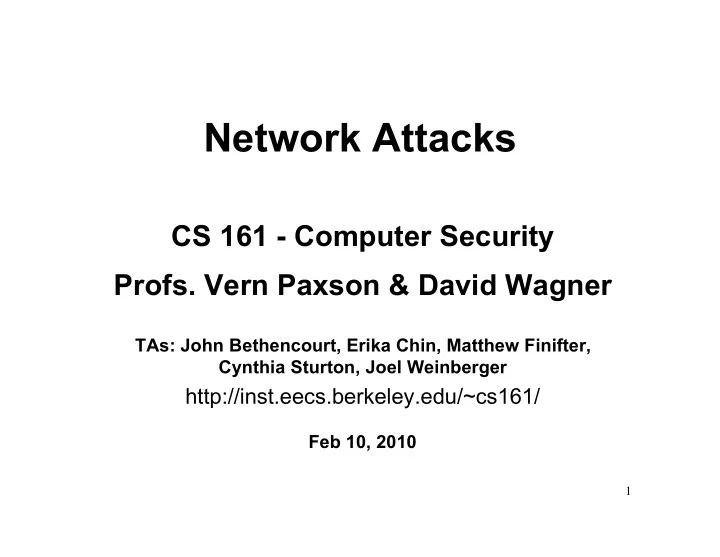

Network Attacks CS 161 - Computer Security Profs. Vern Paxson & David Wagner TAs: John Bethencourt, Erika Chin, Matthew Finifter, Cynthia Sturton, Joel Weinberger http://inst.eecs.berkeley.edu/~cs161/ Feb 10, 2010 1
Announcements / Game Plan • Homework #1 due tomorrow (Thurs 2/11, 11:59PM) – Turn in via hardcopy to drop box in 283 Soda • Project #1 now out, due Thurs 2/18 – Turn in electronically • Goal for today: a look at network attacks – With a focus on network layers 1-4 2
Layers 1 & 2: General Threats? Framing and transmission of a collection of bits into individual messages sent across a 7 Application single “subnetwork” (one physical technology) 4 Transport 3 (Inter)Network Link 2 Encoding bits to send them over a single physical link 1 Physical e.g. patterns of voltage levels / photon intensities / RF modulation 3
Physical/Link-Layer Threats: Eavesdropping • For subnets using broadcast technologies (e.g., WiFi, some types of Ethernet), get it for “free” – Each attached system ’s NIC (= Network Interface Card) can capture any communication on the subnet – Some handy tools for doing so o Wireshark o tcpdump / windump o bro (demo) • For any technology, routers (and internal “switches”) can look at / export traffic they forward • You can also “tap” a link – Insert a device to mirror physical signal – Or: just steal it! 4
Stealing Photons 5
6
Physical/Link-Layer Threats: Disruption • With physical access to a subnetwork, attacker can – Overwhelm its signaling o E.g., jam WiFi’s RF – Send messages that violate the Layer-2 protocol’s rules o E.g., send messages > maximum allowed size, sever timing synchronization, ignore fairness rules • Routers & switches can simply “drop” traffic • There’s also the heavy-handed approach … 7
8
Physical/Link-Layer Threats: Injection • With physical access to a subnetwork, attacker can create any message they like • May require root/administrator access to have full freedom • Particularly powerful when combined with eavesdropping – Can manipulate existing communications 9
Layer 3: General Threats? Bridges multiple “subnets” to 7 Application provide end-to-end internet 4 Transport connectivity between nodes 3 (Inter)Network 4-bit 8-bit Link 4-bit 2 16-bit Total Length (Bytes) Header Type of Service Version Length (TOS) 1 Physical 3-bit 16-bit Identification 13-bit Fragment Offset Flags 8-bit Time to 8-bit Protocol 16-bit Header Checksum Live (TTL) 32-bit Source IP Address 32-bit Destination IP Address IP = Internet Protocol Payload 10
Network-Layer Threats • Major: – Can set arbitrary source address o “ Spoofing ” - receiver has no idea who you are – Can set arbitrary destination address o Enables “ scanning ” - brute force searching for hosts • Lesser: (FYI; don’t worry about unless later explicitly covered) – Fragmentation mechanism can evade network monitoring – Identification field leaks information – Time To Live allows discovery of topology – TOS can let you steal high priority service – IP “options” can reroute traffic 11
Layer 4: General Threats? End-to-end communication 7 Application between processes 4 Transport (TCP, UDP) 3 (Inter)Network Source port Destination port Link 2 Sequence number 1 Physical Acknowledgment HdrLen Advertised window Flags 0 Checksum Urgent pointer Options (variable) Data 12
TCP Threat: Disruption • Normally, TCP finishes (“closes”) a connection by each side sending a FIN control message – Reliably delivered, since other side must ack • But: if a TCP endpoint finds unable to continue (process dies; info from other “peer” is inconsistent), it abruptly terminates by sending a RST control message – Unilateral – Takes effect immediately (no ack needed) – Only accepted by peer if has correct sequence numbers • So: if attacker knows sequence numbers … 13
Tools For Disruption Demo • netcat (sometimes “nc”) s = socket(AF_INET, SOCK_RAW, IPPROTO_RAW); – Can listen or send on ... arbitrary TCP port char pkt[pktlen]; • telnet (std. Unix utility) struct ip *ip = (struct ip *) pkt; – Sends ASCII to ... arbitrary TCP port ip‐>ip_v = IPVERSION; • bro (bro-ids.org) ip‐>ip_len = pktlen; – Programmable network ip‐>ip_off = 0; analyzer/monitor ip‐>ip_src = from; ip‐>ip_dst = to; • inject ip‐>ip_hl = 5; – Custom Unix utility for ip‐>ip_p = IPPROTO_TCP; forging packets ip‐>ip_ttl = 255; 14
TCP Threat: Injection • If attacker knows sequence numbers, can inject whatever they like into TCP connection • Instead of a RST, how about data? • Note: desynchronizes client & server – They have inconsistent views of the byte stream and what acknowledgments refer to – However, if you’ve already killed one end with a spoofed RST, doesn’t matter ⇒ TCP session hijacking – General means to take over an already-established connection! – We are toast if an attacker can see our TCP traffic 15
TCP Threat: Blind Spoofing • TCP connection establishment: Server ( 5.6.7.8) Client ( 1.2.3.4 ) S Y N , S e q N u m = x Each host tells its Initial Sequence Number (ISN) SYN + ACK, SeqNum = y, Ack = x + 1 to the other host. (Spec says to pick based on local clock) A C K , A c k = y + 1 • How can an attacker create an apparent connection from 1.2.3.4 to 5.6.7.8 even if they can’t see the real 1.2.3.4 ’s traffic? 16
Blind Spoofing: Attacker ʼ s Viewpoint Attacker can Server ( 5.6.7.8) Client ( 1.2.3.4 ) spoof this S Y N , S e q N u m = x Each host tells its Initial But can’t Sequence Number (ISN) see this SYN + ACK, SeqNum = y, Ack = x + 1 to the other host. (Spec says to pick based on local clock) A C K , A c k = y + 1 So how do they Hmm, any way know what to for the attacker put here? to know this? Sure - make a non-spoofed How Do We Fix This? connection first , and see what server used for ISN y then! Use a random ISN 17
Recommend
More recommend